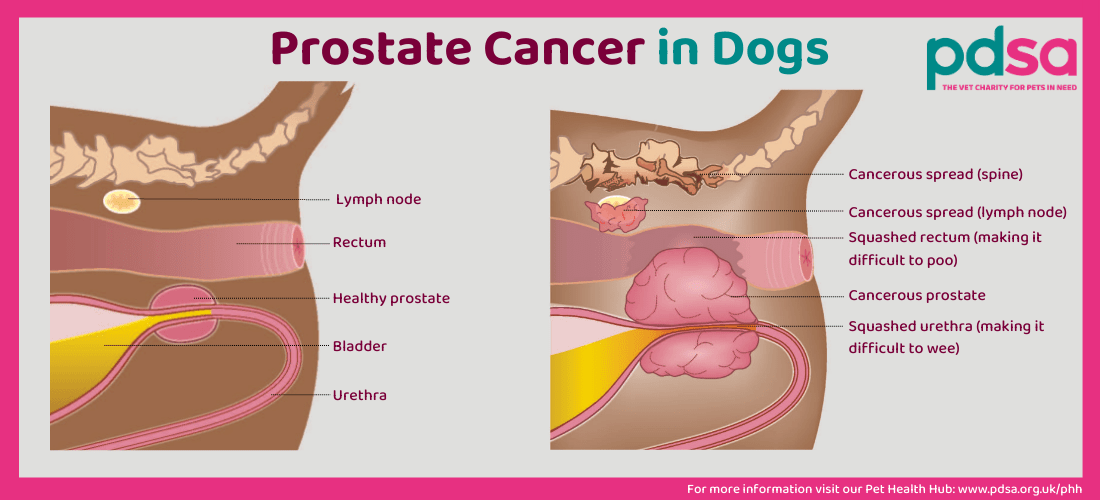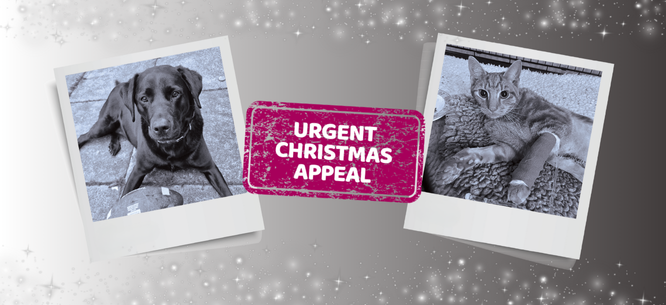Prostate Cancer in Dogs
Overview
- Prostate cancer is uncommon in dogs but sadly, when it does occur it tends to be aggressive, fast-growing, and very quick to spread around the body.
- Prostate cancer tends to cause problems with weeing and pooing, blood in the urine, abdominal (tummy) pain, and back pain.
- Treating prostate cancer is difficult because of how aggressive it is —sadly in most cases it can’t be cured and the outlook is very poor.

Canine prostate cancer is aggressive, fast-growing, and quick to spread around the body. It doesn’t usually cause symptoms until it’s advanced, so by the time it’s diagnosed it has often caused extensive damage and is difficult to treat. Fortunately, prostate cancer is rare and tends to mostly affect dogs over 10 years old.
For info about other types of prostate disease, read our article ‘Enlarged Prostate in Dogs’.
Symptoms
Your dog is unlikely to show any symptoms of prostate cancer in the early stages of the disease, but as the cancer grows it will start to press on and affect nearby parts of the body and cause symptoms such as:
- Difficulty pooing and weeing — contact your vet straight away if your dog is unable to pass urine
- Flat/ribbon-shaped poos
- Blood in urine
- Urinary incontinence (leaking urine)
- Discharge from the penis (often bloody)
- Back pain
- Abdominal (tummy) pain
As the cancer spreads, they may also develop symptoms such as:
- Wobbly back legs
- Enlarged lymph nodes (glands)
- Low energy
- Reduced appetite
- Weight loss
Diagnosis
If your dog has signs of a prostate problem, your vet will attempt to examine their prostate gland by a rectal exam, or ultrasound scan (if they are large and their prostate is difficult to reach). If the prostate is enlarged or abnormal, they may suggest some further tests such as:
- Blood tests
- A urine sample
- X-rays
- An ultrasound scan (if they haven’t already done so)
- A biopsy (taking a sample) of the prostate
- A CT or MRI scan

The tests will help your vet understand exactly what the problem is, and if it is cancer, will help them to tell what type it is, how aggressive it is, and whether it’s spread.
Treatment
Prostate cancer in dogs tends to be extremely aggressive, making it very difficult to treat. Some treatments can slow prostate cancer growth and control symptoms, but it’s important to be aware that none of these treatments will cure your dog, and their cancer will continue to progress. Speak to your vet about your dog’s options and what you think is right for them. The following palliative treatment may be possible:
- Medication — Pain relief, stool softeners, and antibiotics (if the prostate is also infected).
- NSAIDs — certain types of NSAIDs (non-steroidal anti-inflammatory drugs) can sometimes help prolong the life of dogs with prostate cancer.
- Radiotherapy — Radiotherapy can be used to temporarily relieve prostate cancer symptoms, but won’t cure the cancer completely.
- Chemotherapy — Chemotherapy can sometimes be used to temporarily relieve the symptoms of prostate cancer, but this isn’t successful for every dog.
- Surgery — In the rare case that prostate cancer is found early, it’s sometimes possible to remove the affected part of the gland. However, by the time it’s diagnosed, it’s usually affecting the whole gland and has spread around the body. Removing the whole prostate gland from a dog is not recommended because there is a high chance of complications that impact their quality of life, including lifelong urinary incontinence (urine leaking). It is also a very complex surgery and can only be carried out by a specialist vet.
- Euthanasia — It’s important to talk openly to your vet about what you think is best for your dog. Although it can be hard to accept, if your dog’s cancer is severe, and causing them a lot of pain and discomfort, it may be kindest to consider putting them to sleep.
Types of prostate cancer
There are a few different types of prostate cancer that can develop in dogs, the two most common are the Transitional Cell Carcinoma (TCC), and Adenocarcinoma (ACA). The only way to tell the difference is by taking a biopsy (tissue sample) of the prostate gland.
Transitional Cell Carcinoma (TCC): This is the most common type of prostate cancer in dogs. It mostly affects small breed dogs such as the Scottish Terrier, Shetland Sheepdog, Beagle, Wirehaired Fox Terrier, and West Highland White Terrier. TCC tends to affect middle-aged and older dogs.
Adenocarcinoma (ACA): This type of prostate cancer mostly affects large breed dogs, over 10 years old.
Cost
Treatment for prostate cancer can be very expensive, especially if your dog needs to be referred to a specialist vet hospital. It’s important to speak openly to your vet about your finances and what you think is right for your dog. There is often more than one treatment option, so if one doesn’t work for you and your dog then your vet may be able to offer another.
Consider insuring your dog as soon as you get them, before any signs of illness start. This will ensure you have all the support you need to care for them.
When to contact your vet
It’s important to contact your vet quickly if your dog is showing symptoms of a prostate problem. The sooner they get a diagnosis, the sooner a treatment plan can be put in place.
- Where is the prostate gland?
- What does the prostate gland do?
- Why does prostate cancer cause straining?
- Will castrating my dog help control prostate cancer?
- Will castrating my dog cause prostate cancer?
Where is the prostate gland?
The prostate gland is a gland that only male dogs have. It sits just inside their bottom between their rectum (back passage) and bladder.
What does the prostate gland do?
The prostate gland produces fluid for sperm to travel in.
Why does prostate cancer cause straining?
Because the prostate sits just under the rectum, and surrounds the urethra (tube that takes urine out of the body), if it becomes bigger than it should be it can squash them both, causing narrowing and problems with peeing/pooing. It also puts pressure around the back end, and can make a dog feel as though they need to wee or poo, causing them to strain.
Will castrating my dog help control prostate cancer?
No, although castration can help control Benign Prostatic Hyperplasia (non-cancerous growth of the prostate), it doesn’t help with the treatment of prostate cancer.
Will castrating my dog cause prostate cancer?
Some studies have suggested that neutered dogs may be at a slightly higher risk of developing a prostate tumour. However, even in neutered dogs, this tumour is still very uncommon, so it’s also important to consider the potential risks of leaving them ‘entire’, for example testicular cancer or behavioural problems. It is always best to discuss your individual dog’s suitability for neutering with your vet.
Published: April 2023
Did you find this page useful?
Tell us more
Please note, our vets and nurses are unable to respond to questions via this form. If you are concerned about your pet’s health, please contact your vet directly.
Thank you for your feedback
Want to hear more about PDSA and get pet care tips from our vet experts?
Sign up to our e-newsletter
Written by vets and vet nurses. This advice is for UK pets only. Illustrations by Samantha Elmhurst.

